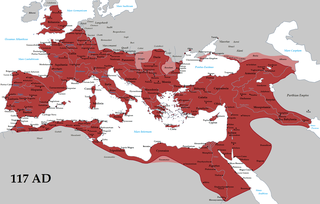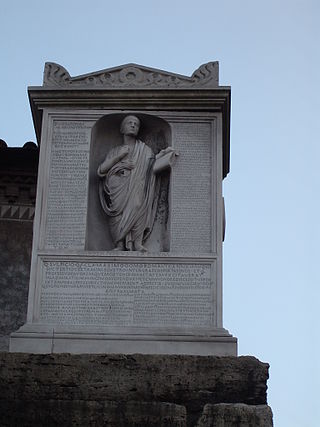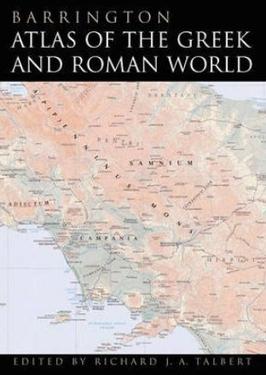Related Research Articles

The Roman Empire was the era of Roman civilisation lasting from 27 BC to 476 AD. Rome ruled the Mediterranean and much of Europe, Western Asia and North Africa. The Romans conquered most of this during the Republic, and it was ruled by emperors following Octavian's assumption of effective sole rule in 27 BC. The western empire collapsed in 476 AD, but the eastern empire lasted until the fall of Constantinople in 1453.

Roman numerals are a numeral system that originated in ancient Rome and remained the usual way of writing numbers throughout Europe well into the Late Middle Ages. Numbers are written with combinations of letters from the Latin alphabet, each with a fixed integer value. The modern style uses only these seven:
In Greek mythology, the Crinaeae were a type of Naiad nymphs associated with fountains or wells.

Pamphylia was a region in the south of Asia Minor, between Lycia and Cilicia, extending from the Mediterranean to Mount Taurus. It was bounded on the north by Pisidia and was therefore a country of small extent, having a coast-line of only about 120 km with a breadth of about 50 km. Under the Roman administration the term Pamphylia was extended so as to include Pisidia and the whole tract up to the frontiers of Phrygia and Lycaonia, and in this wider sense it is employed by Ptolemy.
Greek Orthodox Church is a term that can refer to any one of three classes of Christian churches, each associated in some way with Greek Christianity, Levantine Arabic-speaking Christians or more broadly the rite used in the Eastern Roman Empire.

Ancient Greek literature is literature written in the Ancient Greek language from the earliest texts until the time of the Byzantine Empire. The earliest surviving works of ancient Greek literature, dating back to the early Archaic period, are the two epic poems the Iliad and the Odyssey, set in an idealized archaic past today identified as having some relation to the Mycenaean era. These two epics, along with the Homeric Hymns and the two poems of Hesiod, the Theogony and Works and Days, constituted the major foundations of the Greek literary tradition that would continue into the Classical, Hellenistic, and Roman periods.

Pinnes was the son of Agron, king of the Ardiaei in Illyria, and Agron's first wife Triteuta. He officially succeeded his father as king in 230 BC, but the Ardiaean kingdom was ruled by Agron's second wife, Queen Teuta.

The history of Latin poetry can be understood as the adaptation of Greek models. The verse comedies of Plautus, the earliest surviving examples of Latin literature, are estimated to have been composed around 205–184 BC.

The Barrington Atlas of the Greek and Roman World is a large-format English language atlas of ancient Europe, Asia, and North Africa, edited by Richard J. A. Talbert. The time period depicted is roughly from archaic Greek civilization through Late Antiquity. The atlas was published by Princeton University Press in 2000. The book was the winner of the 2000 Association of American Publishers Award for Best Professional/Scholarly Multivolume Reference Work in the Humanities.

Ancient Greek technology developed during the 5th century BC, continuing up to and including the Roman period, and beyond. Inventions that are credited to the ancient Greeks include the gear, screw, rotary mills, bronze casting techniques, water clock, water organ, the torsion catapult, the use of steam to operate some experimental machines and toys, and a chart to find prime numbers. Many of these inventions occurred late in the Greek period, often inspired by the need to improve weapons and tactics in war. However, peaceful uses are shown by their early development of the watermill, a device which pointed to further exploitation on a large scale under the Romans. They developed surveying and mathematics to an advanced state, and many of their technical advances were published by philosophers, like Archimedes and Heron.
The history of the Illyrians spans from the beginning of the 2nd millennium BC up to the 1st century AD in the region of Illyria and in southern Italy where the Iapygian civilization flourished.

Selinus or Selinous was a port-town on the west coast of Rough Cilicia and later of Isauria, at the mouth of a small river of the same name, now called Musa Çay. It is located west of the modern city of Gazipaşa in Turkey.
A sibyna was a type of spear used for hunting or warfare in ancient times.
Epidaurus or Epidauros was an ancient Greek colony founded sometime in the 6th century BC and renamed to Epidaurum during Roman rule in 228 BC, when it was part of the province of Illyricum and later of Dalmatia. It is located at present-day Cavtat in Croatia, 15 km (9 mi) south of Dubrovnik.
Athyras was a Greek city in ancient Thrace, located in the region of the Propontis.
John Peter Oleson is a Canadian classical archaeologist and historian of ancient technology. His main interests are the Roman Near East, maritime archaeology, and ancient technology, especially hydraulic technology, water-lifting devices, and Roman concrete construction.
Tyriaeum or Tyriaion, also spelled Tyraion, was a Roman and Byzantine era civitas in the Roman Province of Pisidia, located ten parasangs from Iconium It was mentioned by Xenophon, and Pliny and Strabo tell us it was between Philomelium (Akshehr) and Laodicea Combusta. It is tentatively identified with ruins near modern Teke Kozağaçi (Turkey) on the road from Antalya to Denizli or near modern Ilgın.